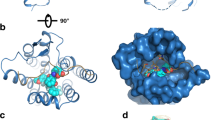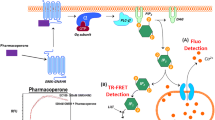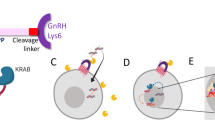Abstract
Gonadotropin-releasing hormone (pyroGlu1-His2-Trp3-Ser4-Tyr5-Gly6-Leu7-Arg8-Pro9-Gly10 amide, GnRH) stimulates pituitary luteinizing hormone (LH) release. An antagonist, D-pyroGlu1-D-Phe2-D-Trp3-D-Lys6-GnRH (GnRH-Ant), binds to the pituitary GnRH receptor and inhibits GnRH-stimulated (10−9 M) gonadotropin release from pituitary cultures (IC50 = 2 × 10×7 M). GnRH-Ant has no measurable agonist activity at concentrations up to 10−6 M. The presence of the D-Lys6 both affords protection against proteolysis and includes an amino group which may be used for derivatization without loss of receptor-binding activity. Formation of the GnRH-Ant dimer by cross-linking of the (lysyl) amino groups of two molecules with ethylene glycol bis(succinimidyl succinate) (EGS) results in a GnRH-Ant dimer joined by a 12–15 Å chain. As the amino terminus on GnRH-Ant is blocked, leaving the D-Lys6 amino group the only reactive group1, the reaction of EGS with GnRH-Ant does not lead to larger polymers. Like the parent compound, this dimer is purely an antagonist. We now show, however, that when antibody (AB) to D-Lys6-GnRH (which cross-reacts with GnRH-Ant) is incubated with excess dimer, a product is formed which consists of a divalent antibody with a GnRH-Ant dimer attached to each arm: AB–((GnRH-Ant)–EGS–(GnRH-Ant))2. In contrast to the parent compounds, this conjugate is an agonist, stimulating LH release from pituitary cultures. Our results suggest that a pure antagonist becomes an agonist when it is capable of bringing two receptor molecules within a critical distance, d (15 Å<d<150 Å). The data indicate that formation of the receptor microaggregate itself is sufficient to stimulate a transmembrane response system.
This is a preview of subscription content, access via your institution
Access options
Subscribe to this journal
Receive 51 print issues and online access
$199.00 per year
only $3.90 per issue
Buy this article
- Purchase on Springer Link
- Instant access to full article PDF
Prices may be subject to local taxes which are calculated during checkout
Similar content being viewed by others
References
Abdella, P. M., Smith, P. K. & Royer, G. P. Biochem. biophys. Res. Commun. 87, 734–742 (1979).
Conn, P. M., Rogers, D. C. & Sheffield, T. Endocrinology 109, 1122–1126 (1981).
Conn, P. M. et al. Endocr. Rev. 2, 174–185 (1981).
Conn, P. M., Chafouleas, J. G., Rogers, D. C. & Means, A. R. Nature 292, 308–309 (1981).
Hazum, E., Cuatrecasas, P., Marian, J. & Conn, P. M. Proc. natn. Acad. Sci. U.S.A. 77, 6692–6695 (1980).
Coon, P. M. & Hazum, E. Endocrinology 190, 1122–1126 (1981).
Conn, P. M., Smith, R. G. & Rogers, D. J. biol. Chem. 256, 1098–1100 (1981).
Hazum, E., Chang, K.-J. & Cuatrecasas, P. Nature 282, 626–628 (1981).
Davies, P. J. A. et al. Nature 283, 162–167 (1980).
Schechter, Y., Hernaez, L., Schlessinger, J. & Cuatrecasas, P. Nature 278, 835–838 (1979).
Jacobs, S., Chang, K.-J. & Cuatrecasas, P. Science 200, 1283–1284 (1978).
Kahn, C. R., Baird, K. L., Jarrett, D. B. & Flier, J. S. Proc. natn. Acad. Sci. U.S.A. 75, 4209–4213 (1978).
Gopalkrishnan, P. V. & Karush, F. Immunochemistry 11, 279–283 (1974).
Valentine, R. C. & Green, N. M. J. molec. Biol. 27, 615–617 (1967).
Burton, K. Biochem. J. 62, 315–323 (1956).
Marian, J. & Conn, P. M. Life Sci. 27, 87–92 (1980).
Marian, J., Cooper, R. L. & Conn, P. M. Molec. Pharmac. 19, 399–405 (1981).
Seon, B. K. & Pressman, D. J. Immun. 113, 1190–1198 (1974).
Fleischman, J. B., Pain, R. & Porter, R. R. Archs Biochem. Biophys. Suppl. 1, 174–180 (1961).
Author information
Authors and Affiliations
Rights and permissions
About this article
Cite this article
Conn, P., Rogers, D., Stewart, J. et al. Conversion of a gonadotropin-releasing hormone antagonist to an agonist. Nature 296, 653–655 (1982). https://doi.org/10.1038/296653a0
Received:
Accepted:
Issue Date:
DOI: https://doi.org/10.1038/296653a0
This article is cited by
-
Gonadotrophin-releasing hormone (GnRH)
British Journal of Pharmacology (2006)
Comments
By submitting a comment you agree to abide by our Terms and Community Guidelines. If you find something abusive or that does not comply with our terms or guidelines please flag it as inappropriate.



